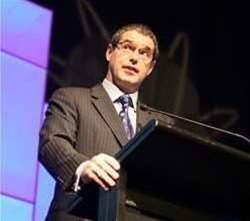Communications minister Senator Stephen Conroy has laid the opposition’s broadband plans to ridicule in a fiery televised speech.

Though marked as an update to NBN construction progress, Conroy used his address before the National Press Club in Canberra on Tuesday to target opposition communications spokesman Malcolm Turnbull and what the Government claims is a negative and inconsistent approach from the coalition.
Accompanied by new adviser and telco expert, David Havyatt, Senator Conroy's speech marked a significant change in tone for the communications minister who has, to date, made small criticisms of the Turnbull's alternative policy but neglected to address it head-on.
Turnbull fleshed out the coalition's alternative in August.
"Mr Turnbull is offering three technologies: FTTN, HFC and wireless. All of them are limited in their ability to provide Australia with the broadband we need," Senator Conroy said.
FTTN a 'dead end'
The Communications Minister sped through a dizzying stream of quotes and charts to support the Federal Government's $36 billion network and slam Turnbull's alternative.
He slammed Turnbull's public push for a staged upgrade to fibre, using fibre-to-the-node as a cheaper mid-point in providing faster broadband speeds before moving to fibre-to-the-home.
Turnbull has often referred to New Zealand's broadband plan as a model, in which the country's incumbent Telecom NZ had rolled out fibre-to-the-node to 85 percent, or 1.4 million New Zealand premises, for $500 million at speeds substantially faster than 5 Mbps.
The country is now embarking on a wider upgrade to fibre-to-the-home at the hands of tendered contractors.
But Senator Conroy attacked Turnbull's costings, arguing the opposition communications spokesman had confused capital expenditures with operating expenditures and had over-estimated its planned coverage of New Zealand from 75 percent to 100 percent.
Former New Zealand communications minister Stephen Joyce had publicly backed away from FTTN, Senator Conroy said.
"So yes, Mr Turnbull, New Zealand does have it right, FTTN is inadequate," he said.
HFC and wireless alternatives ridiculed
Senator Conroy ridiculed Turnbull’s advocacy for hybrid-fibre coaxial and his claim that it alone could serve 30 percent of all Australian homes in the major cities.
The cable networks, primarily operated by Telstra and Optus in some capital cities, have recently been upgraded to support 100 Mbps speeds to the user, the current maximum speed offered by retail service providers under the NBN.
But Senator Conroy was at pains to point out that since HFC is a shared bandwidth medium, the network would slow the more people used it in a street.
Given the the enormous growth in demand for capacity by end-users, HFC was a dead-end solution, he said.
Likewise, the Opposition’s attraction to wireless as an alternative to fibre was misconceived.
"Wireless has similar, yet more profound limitations, than HFC," he said.
While it worked well in low-density areas where there is capacity to share, again the more people that used it, the slower it became.
“[Turnbull] is planning a network that will be obsolete by the time it is built," Senator Conroy said, winding up his attack.
"He will leave us stranded and locked into today’s speeds. According to Mr Turnbull, no one, anywhere in the world, will develop anything new."
NBN progress
Senator Conroy declared 2011 "a year of great progress” for the NBN, with more than 18,000 premises passed by fibre and 3000 customers connected to the network.
Since beginning of construction on the network, however, Australia's fixed broadband penetration had slipped in OECD ranking from 18th to 21st of 34 OECD countries in June 2011.
“One of the reasons we are investing in the NBN is because we don’t want to slip any further,” Senator Conroy when asked about the issue by iTnews.
"We are standing still. A lot of these other countries are investing in new next generation networks."
He reaffirmed the Government’s Digital Economy Strategy to be within the top five of OECD countries by 2020.
“We are embarking on this project because broadband is a serious issue, and the Labor Party treats it as such,” he said.




_(20).jpg&h=140&w=231&c=1&s=0)




_(26).jpg&w=100&c=1&s=0)

 iTnews Executive Retreat - Security Leaders Edition
iTnews Executive Retreat - Security Leaders Edition












_(1).jpg&h=140&w=231&c=1&s=0)



